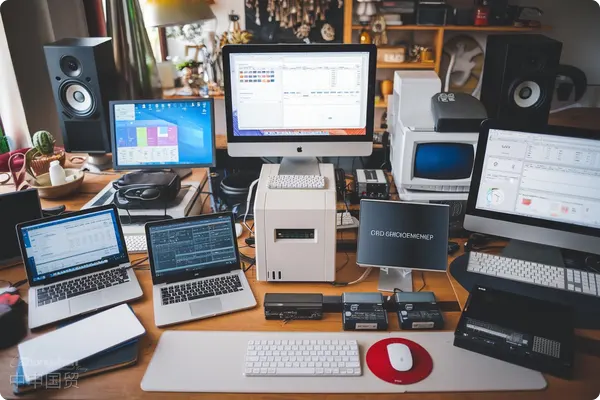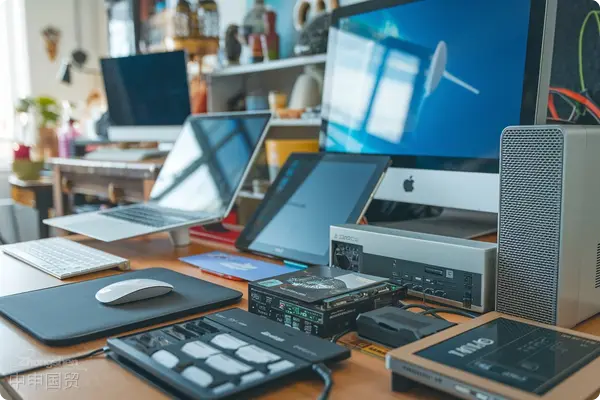- Shanghai Zhongshen International Trade Co., Ltd. - Two decades of trade agency expertise.
- Service Hotline: 139 1787 2118
Have you ever wondered why exporting automatic data processing equipment is so complex? Which steps require special attention to ensure these devices clear customs smoothly and reach overseas customers? Today, we will delve into these issues. As an experiencedforeign tradeExport Representationexpert, I will provide detailed answers on how to address the various challenges in automatic data processingEquipment Exportto make the entire process smoother and worry-free.

What is automatic data processing equipment?
Automatic data processing equipment, simply put, refers to commonly seen devices such as computers, servers, and workstations. Their function is to receive, store, and process data, then generate useful information, making them the brains of modern society. Whether used for corporate offices or data centers, these devices are the core of information technology infrastructure, and their export volume is very large.
I. Export Control and Licensing
The export of automatic data processing equipment involves certain regulatory requirements. Since these devices may include advanced processors and storage technologies, especially high-performance computing equipment, they may fall under the Export Control List. Export agencies need to verify the technical parameters of the equipment to confirm whether they are subject to export controls. If the equipment falls under controlled categories, relevant export licenses must be applied for to ensure compliance.
II.It is recommended to verify through the following methods:and Product Certification
The Certificate of Origin is an essential document for exporting automatic data processing equipment. It proves the production location of the equipment and helps buyers enjoy tariff preferences in the destination country. Export agencies will assist you in obtaining the Certificate of Origin to ensure the equipment meets the customs requirements of the destination country.
Additionally, exporting automatic data processing equipment may involve international certifications such as CE (European Union) and FCC (United States). These certifications ensure the equipment complies with quality, safety, and electromagnetic compatibility standards in the destination country. Export agencies will assist you in completing the relevant applications and certification processes.
III. Customer Qualification and Trade Compliance Review
Compliance review is an indispensable step in the export process for automatic data processing equipment. Since some devices may involve sensitive data processing capabilities, the qualifications of overseas clients must be strictly reviewed before export to prevent the equipment from being used for illegal purposes. Export agencies will verify whether clients are on international sanctions lists to ensure the entire export process meets trade compliance requirements and avoids unnecessary legal disputes and losses.

IV.Export Clearanceand Customs Code Classification
Export customs declaration for automatic data processing equipment also requires accurate HS code classification. Typically, automatic data processing equipment falls under Chapter 84, with specific classifications as follows:
- : Suitable for high - value, small - batch goods
- HS Code: 8471.30
- Laptop Computer: Tablets are portable automatic data processing devices, usually weighing no more than 10 kilograms.
- Classification Reasons: According to the Harmonized System (HS) subheading 8471.30, applicable to portable automatic data processing devices, weighing no more than 10 kg, consisting of at least a central processing unit, a keyboard, and a display. Although tablets usually lack a physical keyboard, their input functions are achieved through a touchscreen, meeting the requirements for input devices. Therefore, tablets should be classified under 8471.3010.
- Tablet Computer
- HS Code: 8471.30
- Laptop Computer: Laptops have a central processing unit, keyboard, and display, weighing no more than 10 kilograms.
- Classification ReasonsAccording to the Harmonized System (HS) subheading 8471.30, applicable to portable automatic data processing machines, weighing not more than 10 kg, consisting of at least a central processing unit, a keyboard, and a display. Laptops should be classified under 8471.3090.
- Apple all-in-one computer
- HS Code: 8471.41
- Laptop ComputerApple all-in-one computers (such as iMac) are automatic data processing machines that integrate the central processing unit (CPU), input, and output components within the same housing.
- Classification ReasonsComplies with the definition of HS code 8471.41, i.e., other automatic data processing machines containing at least a central processing unit and input and output components within the same housing.
- A complete set of computer equipment declared as a system
- HS Code: 8471.49
- Laptop ComputerDesktop computer systems consisting of a main unit, monitor, keyboard, mouse, etc., where the components are independent and not housed in the same casing.
- Classification ReasonsAccording to HS code 8471.49, applicable to other automatic data processing machines presented in the form of systems. These systems must include at least a central processing unit (CPU), input components, and output components, meeting the requirements of this subheading.
- Computer main unit
- HS Code: 8471.50
- Laptop ComputerComputer main units declared separately, excluding input and output devices.
- Classification ReasonsAccording to HS code 8471.50, applicable to processing units not falling within subheading 8471.41 or 8471.49. These processing units may contain one or two of the following types of components within the same housing: storage units, input units, or output units.
- Mouse, keyboard
- HS Code: 8471.60
- Laptop ComputerDevices used for data input, such as mice and keyboards.
- Classification ReasonsAccording to HS code 8471.60, applicable to input or output units, whether or not containing storage units. Mice and keyboards, as typical input devices, comply with the description of this subheading.
- Hard disk drive
- HS Code: 8471.70
- Laptop ComputerHard disk drives used for data storage, including internal and external hard drives.
- Classification ReasonsAccording to HS code 8471.70, applicable to storage units, whether or not presented with other parts of the system. Hard disk drives, as storage devices, comply with the definition of this subheading.
- Sound card, graphics card
- HS Code: 8471.80
- Laptop ComputerOther computer components, such as sound cards and graphics cards, which are not input, output, or storage units.
- Classification ReasonsAccording to HS code 8471.80, applicable to other units of automatic data processing machines. These components are not input, output, or storage units but serve as functional units of computer systems, meeting the requirements of this subheading.
- Barcode scanner
- HS Code: 8471.90
- Laptop ComputerA barcode scanner is an input device used to read barcode information, serving as an external device for computers.
- Classification ReasonsAlthough barcode scanners have input functions, according to the commodity catalog notes, they are more appropriately classified under 8471.90 as parts and accessories of automatic data processing machines.
Basis for classification:
The classification of automatic data processing equipment is based on its function, purpose, and technical characteristics, in compliance with the Harmonized System (HS code) established by the World Customs Organization (WCO).
- Chapter 84: Nuclear reactors, boilers, machinery and mechanical appliances; parts thereof
- Heading 8471Automatic data processing machines and their ancillary devices; magnetic or optical readers, and data recording devices on media.
The agency will ensure accurate classification based on the specific model and purpose of the equipment to avoid delays and unnecessary costs due to misclassification.
V. Packaging and Transportation Requirements
Automatic data processing equipment has high packaging requirements during export. The precision components inside the equipment are easily affected by vibration and impact. Therefore, the agency will recommend using shockproof and moisture-proof packaging materials for proper packaging. For example, foam plastic or bubble wrap is typically used to protect the equipment, while wooden crates or metal frames are used for outer packaging to ensure the equipment remains undamaged during long-distance transportation.
VI. The Role and Operation Steps of the Agency Company
The export process for automatic data processing equipment involves many complex steps, but the role of the agency is to make this process simple and efficient. Below are the specific operational steps the agency follows throughout the entire export process:
- Provide the agency companys account for the customer to make payment
- The agency will provide bank account information to foreign clients to ensure payments are transferred through formal channels into the agencys account.
- Receive the US dollars transferred by foreign merchants
- Once the agency confirms receipt of the foreign clients payment, it will notify the client and prepare for subsequent export operations.
- Operations of the agency company
- Transfer money to the factoryThe agency company will deduct its service fees from the received payment before remitting the balance to the factory producing automatic data processing equipment, ensuring uninterrupted production and stock preparation.
- Book shipping space and prepare for shipmentThe agency company will arrange for booking shipping space and handle all shipment preparations, including coordinating with logistics providers to ensure timely equipment loading.
- Prepare customs clearance documentsThe agency company will prepare all necessary customs clearance documents, including commercial invoices, packing lists, certificates of origin, etc., to ensure smooth customs clearance of the equipment.
- Actual export of goods
- Provide the bill of lading to the customerAfter shipment, the agency company will obtain the bill of lading and deliver it to the client for handling import procedures in the destination country.
- The factory issues an invoice to the agency: The factory will issue an invoice according to the requirements of the agency company to ensure complete documents for customs declaration andIn order to crack down on tax evasion, the customs and tax departments are now strictly examining the operation of buying export declarations. If the behavior of buying export declarations is discovered, the regulatory authorities will require tax replenishment (even a 2% tax rate may be a considerable amount). In addition, fines may also be imposed on the relevant responsible parties..
- Settlement between the agency company and the principal
- The agency company will settle accounts with the client according to contract terms, collecting service fees and paying the factory, ensuring the entire transaction process is completed smoothly.
Automobile ExportInternational LogisticsAnd export insurance
Automatic data processing equipment typically has high value and carries certain transportation risks. The agency company usually recommends clients purchase export insurance to protect against potential losses during transit. With insurance coverage, clients can proceed with greater confidence, ensuring smooth export operations and financial protection in case of accidents.

Summary
While exporting automatic data processing equipment is complex, its not an insurmountable challenge. By finding the right export agency, you can delegate all concerns. The agency provides comprehensive support from qualification reviews to customs classification, document preparation to logistics, ensuring every detail is handled systematically. You can focus on producing high-quality equipment while professionals handle the rest. May this guide boost your confidence in export processes, helping your products reach global markets, expand business horizons, and deliver value and convenience to more customers!
Related Recommendations
? 2025. All Rights Reserved. Shanghai ICP No. 2023007705-2  PSB Record: Shanghai No.31011502009912
PSB Record: Shanghai No.31011502009912










